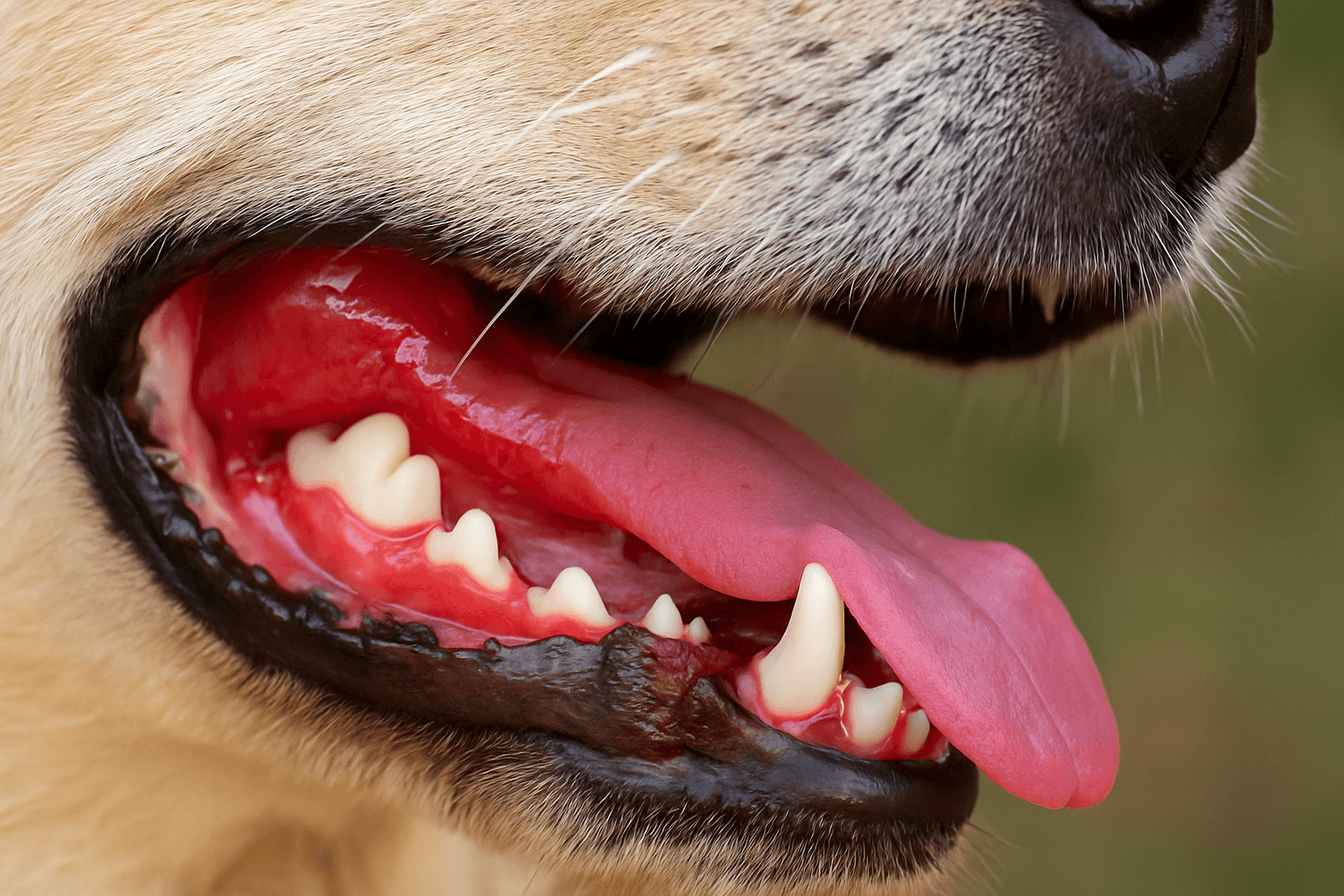When you're snuggling with your pup and notice their gums look unusually bright red, it’s enough to raise your blood pressure. Healthy dog gums should be a soft pink—so when they shift to a vivid red, it's your dog's way of saying, "Hey, something’s not right!" In this post, we’ll dig into what bright red gums in dogs might mean—from inflammation and infection to emergency signs like heatstroke.
🐾 Dog Gum Color Health: What’s Normal?
Before we dive into the possible causes, let’s talk about what healthy gums in dogs should look like. Typically, your dog’s gums should be:
- Light to medium pink
- Moist and slick, not sticky
- Responsive to a quick press (they should turn white and return to pink in under 2 seconds)
This is known as the capillary refill test—and it’s a quick way to assess circulation and general health. Dog mouth color changes are one of the first visible signs something’s wrong, so don’t ignore them!
🚨 What Do Bright Red Gums in Dogs Mean?
Bright red gums are often associated with increased blood flow or inflammation. Here are the top culprits:
1. Oral Inflammation (Gingivitis)
If your dog’s gums are red along the gumline, swollen, and maybe even a little smelly, you might be dealing with canine gingivitis. This is often caused by tartar buildup, poor dental hygiene, or underlying dog gum disease symptoms.
- Look for signs like drooling, pawing at the mouth, and reluctance to eat.
- Try daily brushing and dental chews—Check out our top dental treats.
2. Dog Gum Infection or Abscess
Dog gum infections can occur when bacteria sneak into the gum tissue—often after a fractured tooth or gum injury. You may see pus, swelling, or a bad odor.
This is a pet dental emergency sign and usually requires antibiotics or even surgery. Trust your gut—if your dog’s acting off and their gums look angry red, it’s vet time.
3. Heatstroke or Overheating
One of the lesser-known dog heatstroke symptoms is—you guessed it—bright red gums. As the body overheats, blood vessels dilate in an attempt to cool down.
- Watch for heatstroke warning signs in dogs like excessive panting, drooling, vomiting, and lethargy.
- Always provide shade and fresh water on warm days, and avoid midday walks.
4. Other Emergency Dog Health Symptoms
In some cases, bright red gums can signal shock, poisoning, or internal bleeding. While rare, these situations are critical.
If your dog’s gums are bright red and they seem disoriented, weak, or are vomiting—don’t wait. This could be one of those vet signs to watch in dogs.
🩺 How to Check Your Dog’s Gums at Home
Checking your pup’s gums regularly helps you track health changes early. Here's how:
- Gently lift the lip near the canine teeth.
- Look at the color and moisture level.
- Do the capillary refill test by pressing with your finger for 1 second and timing the color return.
Make it a bonding moment—my Labrador, Daisy, thinks it’s just another excuse to get chin rubs!
✅ When to See the Vet
Always trust your instincts. If you’re seeing red gums in dogs along with symptoms like bad breath, pain, fever, or behavior changes, call your vet. Unhealthy dog gums can be a red flag for bigger health issues.
🦴 Prevention Tips & Healthy Mouth Habits
- Brush your dog’s teeth 2–3 times per week with pet-safe toothpaste.
- Use dental chews or water additives approved by your vet.
- Feed a balanced diet that supports oral health—Check out more healthy treats for dogs.
- Schedule annual dental exams to catch issues early.
🐶 Final Woof
Causes of red gums in dogs range from harmless to serious, but they’re always worth checking out. Your dog can’t tell you when something hurts, but their gums? They’re loud and clear about it. From dog gum inflammation to heatstroke warning signs, staying informed is the best gift you can give your pup.
Stay vigilant, stay loving, and keep those gums pink!
Frequently Asked Questions (FAQs)
1. What do bright red gums in dogs usually indicate?
2. How can I tell if my dog’s red gums are an emergency?
3. Can heatstroke cause red gums in dogs?
4. What are the signs of a dog gum infection?
5. How often should I check my dog’s gums?
6. Is brushing really necessary to prevent dog gum disease?

About SniffnTail
SniffnTail is your go-to destination for everything pets. From helpful advice, tips, and insights to thoughtfully selected products and resources, we’re here to support pet owners at every stage of their journey. Whether you're caring for a playful pup, a wise old cat, or anything in between, SniffnTail offers tools and knowledge to make pet parenting easier and more joyful.
Related Articles
 Health & Wellness • 5 mins Read
Health & Wellness • 5 mins ReadSalmon Oil for Pets: Benefits, Usage, Dosage & Can Cats Have It Too?
If you want to give your furry pal a natural health boost, salmon oil for pets could be your ticket to gold. Full of omega-3 fatty acids and other nutrients, salmon oil has become the go-to pet supplement for pet owners who only want the very best for their dogs and cats.
 Health & Wellness • 6 min read
Health & Wellness • 6 min read10 Signs Your Dog Is Healthy: A Vet-Approved Guide for Pet Parents
Discover the top 10 signs that show your dog is healthy and thriving. Learn expert tips on what to watch for to keep your furry friend happy and well.
 Health & Wellness • 7 min read
Health & Wellness • 7 min readJack Russell Terrier Nervous Behaviors: From Energy to Anxiety
Discover how to understand and manage Jack Russell Terrier nervous behaviors across the hyperactivity-anxiety spectrum with practical tips and expert advice.

